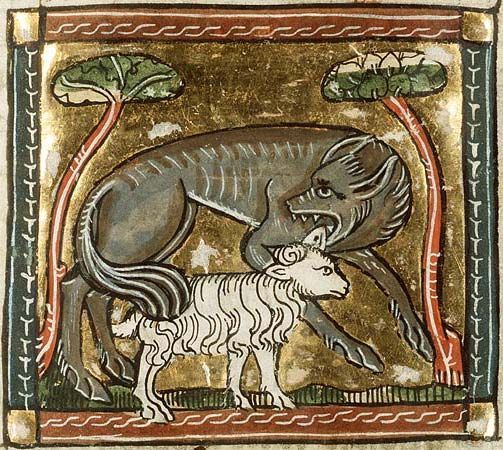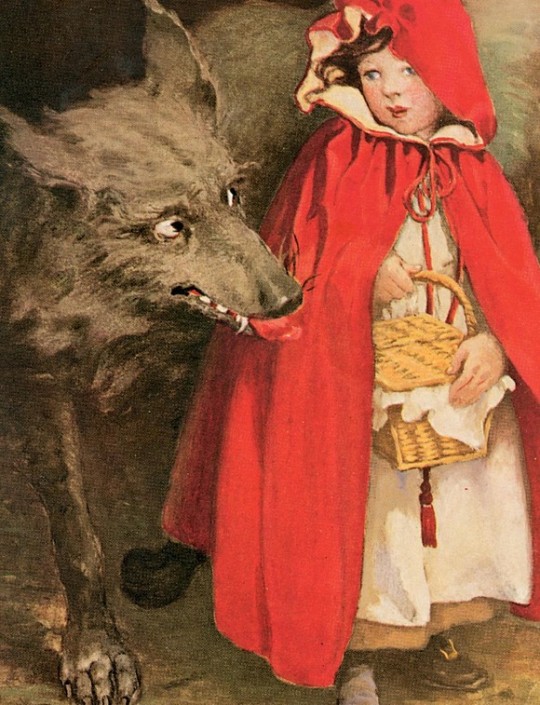Gluttony (and swallowing things whole)
You’ve probably heard those stories about wolves swallowing people whole. Sometimes they’re werewolves. So… why is that?
In the Middle Ages, wolves were considered beings of two things: wrath and gluttony. Plenty of bestiaries will tell you exactly how almost any animal is possessed by Satan and actually a manifestation of one of the Seven Deadly Sins. For wolves, Wrath is certainly mentioned, but more often than not, it actually takes the back seat. Wolves? They’re Gluttony.

The voracity of wolves is certainly exaggerated in bestiaries and legend, but it’s not to be underestimated in real life, either. Wolves can eat approximately 22.5 pounds in one go if they’re allowed.
They eat very fast, so that they can eat as much as possible before they’re driven away from the meal by another wolf or something else, which is where we get “wolfing down” your food, because who needs chewing when you can just swallow and get more of it in? But no, wolves do not swallow things whole and alive in real life. They may not always chew much, but that doesn’t mean they go quite that far. I mean, you know. Definitely, at least, not goats, and not little girls, either.
Regardless, wolves have a really bad rap in many stories (you all know the Big Bad Wolf, who, let’s face it, is a badass when he’s reinterpreted to have even the smallest iota of intelligence). Sure, it varies, but ask any fairy tale what a wolf is and it’ll tell you “irredeemably evil and often bloody stupid” and leave it at that.

And now we come into “Little Red Riding Hood.” You knew it was coming. We all know the story: little girl goes walking through the woods, meets a wolf, wolf eats grandma, pretends to be grandma, swallows little girl whole.
We’re stopping there. Yep, you heard me. In the original story, Little Red… well… she stays in there. There’s no lumberjack coming to save the day and cut her free of the wolf that apparently can’t feel pain (I guess all fairy tale wolves can’t?) and wake up. “Little Red Riding Hood”‘s happy ending was tacked on later, originally she is eaten, the end.
We also have “The Wolf and the Seven Little Kids,” which has some title variations, but it’s generally the same story. There’s a family of goats, an evil wolf – the wolf disguises himself, tricks the goats, swallows them all except one who tells their mother. Mother goat cuts open the wolf’s belly while he’s asleep, gets her still-alive kids out, fills wolf’s belly with stones – wolf drinks from a river, ends up drowning because he’s a moron with a stomach full of rocks, the end. (Again, wolves in fairy tales apparently can’t feel their stomachs getting cut open, how convenient, right?)
There are plenty of other fairy tales that include wolves too voracious for their own good. It’s a running theme with the wolves.
This theme continues into mythology, as well.

Mythology of all kinds is loaded (you might even say stuffed) with instances of people and animals swallowing things… they probably shouldn’t. Alive or inanimate objects. I’m looking at you, Kronos, buddy. You know that was over the top, swallowing your kids like that, and you swallowed a rock for it, now didn’t you? Kronos is by no means the only example.
In Norse mythology, we get all kinds of giant wolves swallowing things. Fenrir is destined to swallow Odin whole in Ragnarok, the end of the world – Fenrir being one of the single scariest beings in all of Norse myth. You also have the wolves Skoll and Hati, or Manegarm. Skoll chased the sun, and Hati chased the moon – and when Gullinkambi, the legendary rooster, sounds the coming of Ragnarok, Skoll will finally reach and swallow the sun, while Hati will swallow the moon.
I’m sure there are plenty of other instances of this sort of thing that I’m missing, but I think you get the idea. Wolves in legend like to not chew before swallowing. Which can make for a fun story, but if you ask fairy tales, that doesn’t really end well for the wolf. Should I write a story that does?
Maybe I should. I think I will. Definitely doing that.
And now we get some things here and there doing this with werewolves, too. Werewolves are now (and indeed plenty of them always have been) often closely associated with hunger, sometimes a voracious and insatiable hunger that drives them and they need to, but can’t always, resist. Plenty of werewolves have also inherited the folkloric wolf’s ability and tendency/preference to swallow people (and other things) whole. I’m not saying I dislike any of these things, by the way. In fact, I do actually love them.
Part of being a werewolf was often a test of will, as I’ve mentioned before. Can the werewolf resist using their power for evil? Can they resist eating livestock and especially their greatest temptation and greatest hunger, eating people? This happened especially in ancient Greece (Lycaon, Arcadia, etc) but there are other examples, too.
So what do we need? We need stories where these voracious wolves and/or werewolves win. The kind that swallow things alive and the kind that don’t. I mean, come on. Try to tell me you don’t want the wolves to win. Wolves are the best.
Yes, wolves and werewolves invented vore long before it was cool. Respect it! True it wasn’t a nice vore, sadly, but you know, we can always take slight departures from the original myths… Oh, and if you’re unfamiliar with vore, and preferably even if you are, don’t google it – read about it here! Before you judge.